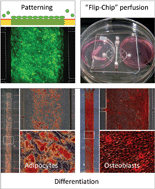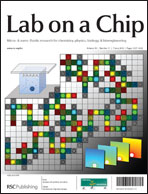Microtechnology offers great prospects for cellular research by enabling controlled experimental conditions that cannot be achieved by traditional methods. This study demonstrates the use of a microfluidic platform for long-term cultivation (3 weeks) of human mesenchymal stem-like cells (MSCs), a cell population of high interest for tissue engineering. The typical high motility of the MSCs required a strategy for preventing cells from inhabiting the feeding channels and thus interfere with a steady perfusion of medium to the cell cultivation chamber. Hence, a straightforward and long-term patterning method was developed and implemented for reliable cell positioning within the device. This method was based on the modification of a polystyrene substrate into cell supportive and non-supportive regions by the use of selective oxygen plasma treatment and the triblock copolymer Pluronic. Also, a novel and size-effective “flip-chip” set-up for operating the devices was invented. Successful and reproducible adipogenic and osteogenic differentiation of MSCs in the device was demonstrated, verifying that an adequate long-term microfluidic cultivation environment was obtained. Strengths of the experimental protocol include ease of fabrication and maintenance (gravity driven), good cell performance (viability/differentiation), as well as the possibility of exposing the culture to heterogeneous laminar flow for experimental purposes.

You have access to this article
 Please wait while we load your content...
Something went wrong. Try again?
Please wait while we load your content...
Something went wrong. Try again?


 Please wait while we load your content...
Please wait while we load your content...